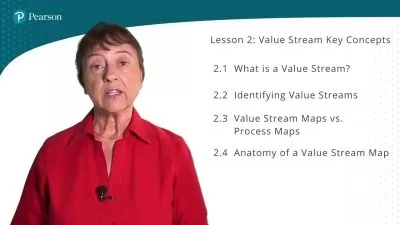The Complete Investor Bootcamp
365 Careers
12:20:00
Description
The Key to Successful, Profitable, and Sustainable Future? Investing. (Learn How to Make Money in the Stock Market)
What You'll Learn?
- How to read a company’s summary page on Yahoo Finance
- Download historical stock prices
- Calculate rates of return and volatility measures
- Compare the risk and return profiles of different securities
- Calculate risk and return of a portfolio of stocks
- Understand the concepts of correlation and diversification
- Build the efficient frontier in Excel/Google Sheets
- Discover how to download a company’s annual 10-K report and how to read it
- Understand the Modern Portfolio Theory and use the Capital asset pricing model to determine expected return on equity in stock valuation models
- Calculate the Sharpe and Treynor ratios, as well as indicators like M2 and Jensen’s alpha
- You will also master fundamental valuation concepts such as fair and market value
- Distinguish between public and private equity securities
- Compare the market and book value of equities
- Calculate the intrinsic value of a stock using the Dividend discount model
- Explain why we use price multiples to value equity securities
- Perform industry analysis
- Use the industry life cycle model
- Define primary and secondary markets
- We will also calculate and interpret the value, price, and total return of an index
- Contrast the different weighting methods used in index construction
- Summarize the factors that affect market efficiency
- Characterize behavioral finance and its relevance to understanding market anomalies
- Review the principles of technical analysis
- Examine common chart patterns
Who is this for?
What You Need to Know?
More details
DescriptionWhat are your financial aspirations?
Are you looking to boost your traditional income or lay the groundwork for early retirement? Or perhaps your ultimate goal is complete financial freedom?
Whatever your vision of success may be, one thing is clear: few factors are as critical to your journey as mastering the knowledge of where and how to invest wisely.
Don’t leave your cash sitting in the bank just because the stock market feels too sophisticated.
Whilst investment manager and mutual fund fees can be very expensive at times, you shouldn’t let this stand in your way.
To get ahead of the game, you can now learn how to invest on your own. Become a prepared investor who understands how the stock market functions.
You don’t need to be an expert in the field of finance. This course will help you unravel the defining concepts of financial markets, right from the get-go. You will learn about value investing and how to measure the performance of stocks, indexes, mutual funds, and ETFs.
We will explain different risk measures, and you will get to know how to be a disciplined investor who is aware of the underlying volatility on the market. That way, you will be better able to earn a living with none of the guessing games and uncertainty.
Put your resources to work and get a clear idea of what kind of investments are available to you today.
This course aims at developing your financial skills and aptitude. The key thing to remember is that there is no magic bullet for making six- and seven-figure profits overnight. This isn’t realistic and you should not trust anyone promising you such outcomes. It’s all about governing your money properly!
What we will do together is cover some very important topics that will build a solid foundation for becoming knowledgeable enough to invest in the stock market. Using your own analysis and forming your own ideas are two of the main skills you will acquire along the way.
In this course, you will also learn how to:
- Download financial data and interpret the data available in different financial sources
- Calculate rates of return and volatility measures
- Understand the concepts of correlation and diversification
- Interpret the Modern Portfolio Theory and use the Capital asset pricing model to determine expected return on equity in stock valuation models
- Build the efficient frontier in Excel
- Calculate the Sharpe and Treynor ratios, as well as indicators like M2 and Jensen’s alpha
- Distinguish between public and private equity securities
- Compute the intrinsic value of a stock using the Dividend discount model
- Use the industry life cycle model
- Define primary and secondary markets
- Calculate and interpret the value, price, and total return of an index
- Contrast the different weighting methods used in index construction
- Characterize behavioral finance and its relevance to understanding market anomalies
- Review the principles of technical analysis, and examine common chart patterns
- Describe the different types of investors, and consider the various aspects of the asset management industry
Don’t forget that the course comes with Udemy’s 30-day unconditional, money-back-in-full guarantee. And why not give such a guarantee, when we are sure the course will provide tons of value for you?
Go ahead and subscribe now! Acquire these skills and leap at the opportunity to set yourself apart from the crowd. Take no chances when planning for your future! Let's start learning together today!
Who this course is for:
- Beginner investors
- Individuals interested in investments
- Investors who want to learn hands-on analysis techniques in Excel/Google Sheets
- People who want to pursue financial freedom
- Individuals who want to pursue a passive income lifestyle
- Anyone interested in stock markets and financial securities
What are your financial aspirations?
Are you looking to boost your traditional income or lay the groundwork for early retirement? Or perhaps your ultimate goal is complete financial freedom?
Whatever your vision of success may be, one thing is clear: few factors are as critical to your journey as mastering the knowledge of where and how to invest wisely.
Don’t leave your cash sitting in the bank just because the stock market feels too sophisticated.
Whilst investment manager and mutual fund fees can be very expensive at times, you shouldn’t let this stand in your way.
To get ahead of the game, you can now learn how to invest on your own. Become a prepared investor who understands how the stock market functions.
You don’t need to be an expert in the field of finance. This course will help you unravel the defining concepts of financial markets, right from the get-go. You will learn about value investing and how to measure the performance of stocks, indexes, mutual funds, and ETFs.
We will explain different risk measures, and you will get to know how to be a disciplined investor who is aware of the underlying volatility on the market. That way, you will be better able to earn a living with none of the guessing games and uncertainty.
Put your resources to work and get a clear idea of what kind of investments are available to you today.
This course aims at developing your financial skills and aptitude. The key thing to remember is that there is no magic bullet for making six- and seven-figure profits overnight. This isn’t realistic and you should not trust anyone promising you such outcomes. It’s all about governing your money properly!
What we will do together is cover some very important topics that will build a solid foundation for becoming knowledgeable enough to invest in the stock market. Using your own analysis and forming your own ideas are two of the main skills you will acquire along the way.
In this course, you will also learn how to:
- Download financial data and interpret the data available in different financial sources
- Calculate rates of return and volatility measures
- Understand the concepts of correlation and diversification
- Interpret the Modern Portfolio Theory and use the Capital asset pricing model to determine expected return on equity in stock valuation models
- Build the efficient frontier in Excel
- Calculate the Sharpe and Treynor ratios, as well as indicators like M2 and Jensen’s alpha
- Distinguish between public and private equity securities
- Compute the intrinsic value of a stock using the Dividend discount model
- Use the industry life cycle model
- Define primary and secondary markets
- Calculate and interpret the value, price, and total return of an index
- Contrast the different weighting methods used in index construction
- Characterize behavioral finance and its relevance to understanding market anomalies
- Review the principles of technical analysis, and examine common chart patterns
- Describe the different types of investors, and consider the various aspects of the asset management industry
Don’t forget that the course comes with Udemy’s 30-day unconditional, money-back-in-full guarantee. And why not give such a guarantee, when we are sure the course will provide tons of value for you?
Go ahead and subscribe now! Acquire these skills and leap at the opportunity to set yourself apart from the crowd. Take no chances when planning for your future! Let's start learning together today!
Who this course is for:
- Beginner investors
- Individuals interested in investments
- Investors who want to learn hands-on analysis techniques in Excel/Google Sheets
- People who want to pursue financial freedom
- Individuals who want to pursue a passive income lifestyle
- Anyone interested in stock markets and financial securities
User Reviews
Rating
365 Careers
Instructor's Courses
Udemy
View courses Udemy- language english
- Training sessions 166
- duration 12:20:00
- Release Date 2025/01/16










